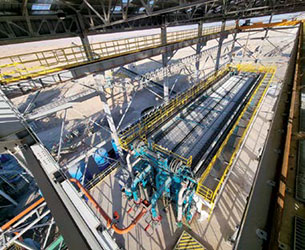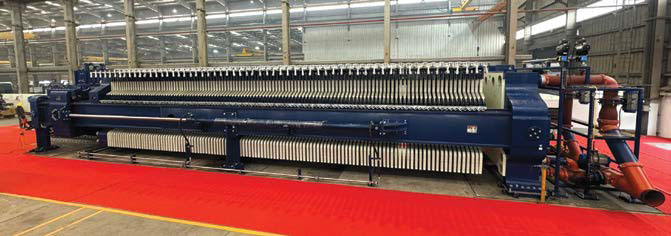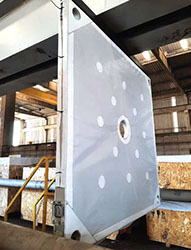
Metso’s Larox FFP3512 and Larox FFP3716 feature a ‘holeless’ filter
cloth. (Photo: Metso)
Mining Companies Turn Attention to
Tailings Filtration
As stakeholders up the ante in responsible tailings management, mine operators are
increasingly looking to filtration technologies to unlock alternative storage solutions.
By Carly Leonida, European Editor

That said, the past five years have seen a significant shift in the feasibility and availability of high-volume, tailings specific dewatering technologies, and an increase in discussions surrounding the topic. This has been evident, for example, in forums such as the Paste 2024 conference which was held in Melbourne, Australia in April. There, tailings filtration was represented to a much greater extent than in previous years.
“This year, we noticed that discussions had shifted towards filtration plants and stockpile management. Whereas in previous years, the focus had been more on paste applications,” Piia Suvio, director for tailings and water at Metso, told E&MJ. “Companies across the board are showing more interest in filtered tailings applications. There are also growing political reasons for moving towards filtered tailings, with many countries either banning wet tailings for new projects or placing very high technical demands on new and, in some cases, existing dam expansions.”
Most major miners have now adopted the Global Industry Standard on Tailings Management and many more are working towards compliance. While tailings filtration and dry stacking is seen as the safest method of disposal, offering many benefits including maximized water recovery, a reduced tailings storage facility (TSF) footprint, greater likelihood of community acceptance and smoother permitting, this method is still the exception rather than the norm.
The primary reason for this is cost, both from a capital (CAPEX) and operating expenditure (OPEX) standpoint. For smaller operators in particular, the upfront investment required to move to filtered tailings can be a roadblock, calling into question the feasibility of certain projects. Meanwhile, for larger players, the sheer volume of tailings produced at their operations poses its own set of feasibility challenges.
Darren Eastwood, business development director at CDE Global, told E&MJ: “Irrespective of the size of operation, the success of implementing improved management processes rests on execution, which requires meticulous planning, stringent project management, and a commitment to best practices.”
Metso Optimizes Filter Offering
In general, miners are concerned that filter solutions are
CAPEX and OPEX intensive, but, when costs are considered
holistically, filtered tailings can be an attractive option.
Suvio explained: “It’s important to use tools such as project-
specific net profit value (NPV) calculations for the whole
lifecycle of the project, including water, closure (rehabilitation,
etc.) and footprint costs, to make sure that filtration is
the most suitable option.”
She added that, despite the safety advantages of filtered tailings, there are still minor risks associated with their storage and management, including geotechnical risks on stack stability, and care should be taken to plan these properly to avoid issues. “We have designed our two largest filter models — the Larox FFP3512 and Larox FFP3716 — specifically for tailings applications, by enabling processing of high volumes and reducing cost constraints,” said Suvio. “Our filters have several design features that assist with minimization of cycle times and operational costs. For example, the plates have a unique design that allow for tangential feeding into the chambers, which in turn allows our filter cloths to be ‘holeless.’ This makes them cheaper to manufacture, and easier to install and maintain, minimizing OPEX and maintenance time (e.g., no need for feeding shoes on each cloth).”
Metso has optimized the availability and space requirements of its filters thus increasing the efficiency and reducing the required footprint, while enabling high capacities. The membrane pressing system, with up to 16 bars of pressure, provides consistent moisture on variable feed grades. “This flexibility also provides confidence that the material will conform with regulatory and geotechnical requirements,” said Suvio. “We also provide a high level of automation to assist with operational challenges.” With its Filtration Plants, Metso uses pre-selected components and auxiliaries, as well as material take-offs to optimize CAPEX and OPEX. These units are also scalable and multiple filters can be added to reach the desired capacity.
“Our model for high-tonnage tailings applications is the Larox FFP3716 pressure filter which has a 2,000 m2 filtration area with 16.5 m2 of effective filtration area per chamber,” said Suvio. “It has the biggest plate of any monoblock unit on the market — other players’ filters use two plates that are bolted together. The feeding shoe in these filters is usually in the middle of the plate, meaning manual work is required to make the shoe holes in the filter cloths. Not having to cut holes saves considerable time and increases the availability of the filter. The way our filter is configured also means it can be transported in a normal ocean container.” Diminishing ore grades are driving Metso’s investigations into different dewatering strategies and technologies. For example, the effect of different filter pressures on slimes and fine grind slurries, and design improvements and technical features to reduce operational costs and boost the circularity of consumables. “We’re also following up on developments in flotation, including coarse flotation, to understand what new demands are coming down the line,” Suvio said.
McLanahan Turbocharges Tech Development With Diefenbach
Dry stacking of filtered tailings is gaining traction across both
the mining and aggregates markets. “The main factors driving
this are TSF safety, achieved by using dry filtered tailings
rather than paste or thickener underflow, and the recovery
of process water,” Cory Jenson, executive vice president of
sales and business development at McLanahan, explained.
“The additional water recovery can be quite substantial, and
the reduction in TSF footprint can make mine planning and
permitting processes much easier.”
To help reduce the cost of implementing dry stacking,
McLanahan completed the acquisition of Italy-based Diefenbach
in 2023. Diefenbach has been making tailings filter
presses for decades and has supplied filter presses into
many industries since 1907.
“With the addition of Diefenbach to the McLanahan family,
we’ve been able to decrease the cost of our tailings solutions
by 40%-50%,” Jenson told E&MJ. “This has created
a compelling value proposition as it allows us to supply
proven tailings filter presses at a very good CAPEX and
OPEX per ton.”
While many filter producers have shifted towards designs with complicated hydraulic systems utilizing two to four hydraulic cylinders, McLanahan has focused on using a single hydraulic cylinder. Jenson said this greatly enhances the speed and long-term reliability of the machines while still providing the same amount of force as multiple cylinders.
“We have some exciting developments in pipeline which we are currently submitting patents for,” Jenson told E&MJ. “Over the next decade, we see more mines of all sizes switching to tailings filtration due to the benefits in water recovery, safety in handling and storing tailings, as well as reduced TSF footprints. We believe this is a long-term trend and are continuing to invest in new developments with Diefenbach. Completing the acquisition has allowed us to accelerate the number of projects we’re executing and quoting with customers around the world.”
Diemme’s Domino Filter Proves Its Worth in Peru
“We’re also witnessing huge growth in demand for our dewatering
technologies,” Andrea Pezzi, director of marketing
and communications at Diemme Filtration (part of the
Aqseptence Group), told E&MJ. “This upward trend also
extends to capacity requirements, requiring the provision of
plants with larger machine groups and/or sizes. All stakeholders
are becoming increasingly mindful of this issue and
are approaching the topic with much greater attention.”

“In terms of our strengths, we’ve recently expanded our facility in Lugo, Italy, with an additional 24,000 m2 of manufacturing space,” said Pezzi. “And in 2021, we introduced the GHT5000F ‘Domino’ filter press to the market which can handle plates with a nominal size of 5,000 x 5,000 mm. Domino is the largest filter press currently in operation worldwide and it’s the largest model in our range. We offer the option to wash filters cloths at both low and high pressures (indicative of increased average lifespan of filter cloths), and our AIDA system provides monitoring and optimization with regular reporting.”
The first GHT5000F is installed at Southern Copper Corp.’s Toquepala mine in Peru. At the time of writing, it had been operational for several months and had already completed over 7,000 cycles. Pezzi said the machine is achieving the expected capacity of 8,000 metric tons per day (mt/d), with a residual moisture level of 15%.
“We have delivered another of these machines to a copper mine in Chile as well, and as soon as the client is ready, we’re prepared to complete installation and commission it,” he added. “Over the next few years, we anticipate a rise in the adoption of tailings dewatering technologies with a growing trend towards employing a combination of technologies, rather than a single one. The selection criteria will be based on various factors, not only economic, but also highly specific to the conditions of individual sites.”
BOKELA: New BoVac Disc Filter for Tailings
BOKELA’s BoVac Disc rotary vacuum disc filters provide advantages
in CAPEX, e.g. through a reduced quantity of filter
units, due to their innovative design and high filtration areas
(up to 352 m2/ unit) on smaller filters. This allows plant footprints
to be minimized, but still with high filter availabilities
of 97% or greater (also reducing the number of required
stand-by units required). OPEX is also lowered through significantly
reduced filter cloth requirements and recycling of
water recovered to the process plant.
André Egger, senior sales manager at BOKELA, told E&MJ: “This is our most advanced filter design and has been continuously improved over the past 25 years, resulting in minimal system pressure losses and maximum throughput per unit.” The newest member of the BoVac Disc filter family is the BoVac Disc XL series (commercially available since mid- 2023), and the largest unit has a nominal filtration area of 352 m2.
“This was the next step in the development of the proven L-series BoVac Disc filter, which has been the primary focus of our R&D in the recent years,” said Egger. “We have over 100 BoVac Disc filters successfully operating in references worldwide, including in tailings duties at mines in Australia, Peru and Sweden. A BoVac Disc XL352 on tailings duty is scheduled for supply at the end of 2024 to another mining operation in Southern Europe.”
According to Egger, interest in the treatment of mine tailings using modern filtration technologies has increased over the past five years, influenced mainly by environmental and safety concerns. However, determination of suitable technologies combined with downstream tailings transport and storage process steps (filtered cake stacking or paste backfill) to provide the lowest possible CAPEX and OPEX is still a challenge. “Many new mines and also existing operations need to switch away from wet tailings in order to gain operating permits so, without a doubt, we’ll see more mines opting for these technologies in the years to come,” he said.
CDE Prepares for Hillhead Product Launch
CDE Global is preparing to launch a new water management
product at the Hillhead event in the UK in late June. Eastwood
spoke to E&MJ in the run up.
“Interest in mine tailings management and settling ponds
has increased significantly in recent years, driven by environmental
concerns, health and safety considerations, OPEX
reductions and more,” he said. “Major mine disasters have
highlighted the need for improved solutions to secure permits,
enhance site safety, and meet sustainability and environmental
goals, such as water recovery and remediation. Operators are
faced with the choice of continuing to store their tailings under
ponds or adopting more proactive management strategies.”

“Mine operators face increasing pressure to implement changes in tailings management practices due to heightened environmental regulations, a growing emphasis on sustainability, and the need to minimize the environmental footprint of operations,” said Eastwood. “Technological advancements, such as CDE’s new holistic water management solution, coupled with a growing recognition of the benefits of reprocessing to extract discarded tailings from dams, offer mines on-site solutions that not only derisk their operations, but also extract value from tailings. This further incentivizes miners to invest in these solutions.”
Jord’s Viper Enhances Dewatering
Australia-based OEM, Jord International’s Viper vacuum belt
filter technology enhances tailings dewatering performance
through the addition of vibration. The vibration induces thixotropic
materials to release water/liquor that is removed from
the process via the vacuum system, resulting in low cake
moisture. The company said that Viper equipped filters can
also operate at a higher production rate relative to conventional
vacuum belt filters.
“Critically, despite the addition of Viper modules, all fundamentals of vacuum belt filter plant design, operational and maintenance practices, which are generally well understood by the mining industry, remain valid. Thus, it provides a solution to help overcome the cost and scalability deterrents of tailings filtration,” Jord said in a recent paper.
Newmont was one of the first adopters and has been operating a dewatering plant fitted with Viper technology since 2017. There are now more than 40 Viper units operating at full scale across various applications, including tailings dewatering, in Australia and Jord said it has numerous projects in implementation in the Americas.
FLS, New AFP2500 Installations
FLS also sees continued increase in tailings filtration due to
dam failures throughout the world, along with greater environmental
awareness.
“These failures have resulted in social and governmental
pressure against large wet impoundments,” said Ken Rahal,
Director of Tailings at FLS. “This pressure can cause delays
to permitting or permit rejections for mines that include wet
impoundments. This is resulting in more miners incorporating
paste, filtered and co-mingled tailings as part of their investigation
into potential alternatives for tailings disposal.”
“Scarcity of water where mines are located and the need
to recycle and reuse this resource is another big driver,”
added Alan Camomile, global product manager for filtration
products at FLS. “While filtering of tailings has been done
for decades, it has predominately been done at relatively
small throughputs.”

“Filtered tailings at lower tonnages have traditionally been placed using trucks and dozers,” said Rahal. “This type of deposition is well understood and accepted by the industry. At large tonnages, especially above 100,000 mt/d, using mobile stacking equipment is more economical than trucks. However, this technology, along with high lifts, has not been used above 50,000 mt/d.” Miners with throughputs higher than this are reluctant to implement this technology without extensive testing. FLS has been involved with multiple lab scale and pilot investigations of this technology. The company is also working with multiple customers for pilot and pre-feasibility studies on its EcoTails co-mingling solution, although this is yet to be implemented in full scale production.
“In recent years, FLS has developed larger filters for high-tonnage applications, including its AFP2500 which replaced the Colossal filter, and has been optimized to provide the lowest TCO for pressure filters of its size,” said Camomile. “This optimization includes improved availability through offline maintenance of the media and plates. It also includes the largest filtration area and volume for a 2.5 m filter.” FLS has now sold AFP2500 filters to three tailings filtration projects: at the Buenaventura San Gabriel gold-silver mine in Peru, Torex Media’s Luna gold mine in Mexico, and Foran Mining Corp.’s McIIvenna Bay copper project in Saskatchewan, Canada. Camomile said the company is currently pursuing a larger format AFP with market analysis guidance.
“FLS is also developing an online moisture analyser to assist in improved running efficiency of filters,” he told E&MJ. “The FLS Intelliplate, which uses an on-plate turbidity sensor to detect filter media failures, is currently in industrial trials. FLS is also trialling its Maxa media for improved cloth life.” The ease of maintenance that is part of FLS filter design means that there is minimal downtime to remove the cloths for cleaning and inspection. Filter cloth life is improved through flow wash optimization that cleans the sealing surfaces, and an offline high-pressure wash can extend media life without long filter down times. Camomile concluded: “Due to water scarcity throughout the world and a reduction in ore grades leading to more tailings being produced, mines will continue to rely on tailings dewatering technologies to meet their social license needs and to support sustainability initiatives.”
Valmet’s High Tech Filter Fabrics
Attention is not only turning to modern
dewatering equipment, but also highly
efficient, long life filter fabrics. Torsti
Lähteenkorva, senior manager, filtration
at Valmet, said the company has
seen a significant increase in interest
in recent years, particularly since the
Brumadinho tailings dam failure in
Brazil in 2019.
“Tailings handling is now an integral
part of mine’s environmental operating
licenses,” said Lähteenkorva. “They
must have proper treatments for tailings
in order to operate.”

“Press filters can process much larger volumes, and the high pressures involved can achieve the required cake dryness for tailings stacking,” Lähteenkorva explained. “Valmet’s fabrics are engineered to meet the customer’s requirement down to the smallest detail, to provide the best possible filtration results, both technically and economically.” According to Lähteenkorva, Valmet tailings fabrics offer excellent abrasion resistance and a long life combined with optimum filtration performance. “Our fabrics provide high capacity and optimum cake dryness,” he said. “Valmet is continuously developing its filter fabric portfolio for tailings with different raw materials, a wide permeability range, and different variations in fabric constructions.”
He added that tailings filtration is not a static process — factors can change daily in a dewatering plant — and follow-up process and filter cloth analyses are important to consistently meeting targets. “In close co-operation with our partners, we’re searching for more sustainable solutions,” Lähteenkorva told E&MJ. “Improving the energy efficiency and water recovery in our customers’ processes is a driving force of our R&D work. We’re also looking for solutions to recycle the materials we use.
“Going forward, safety is the highest priority and mines must start to dewater and dry stack tailings to create operations fit for the future.”